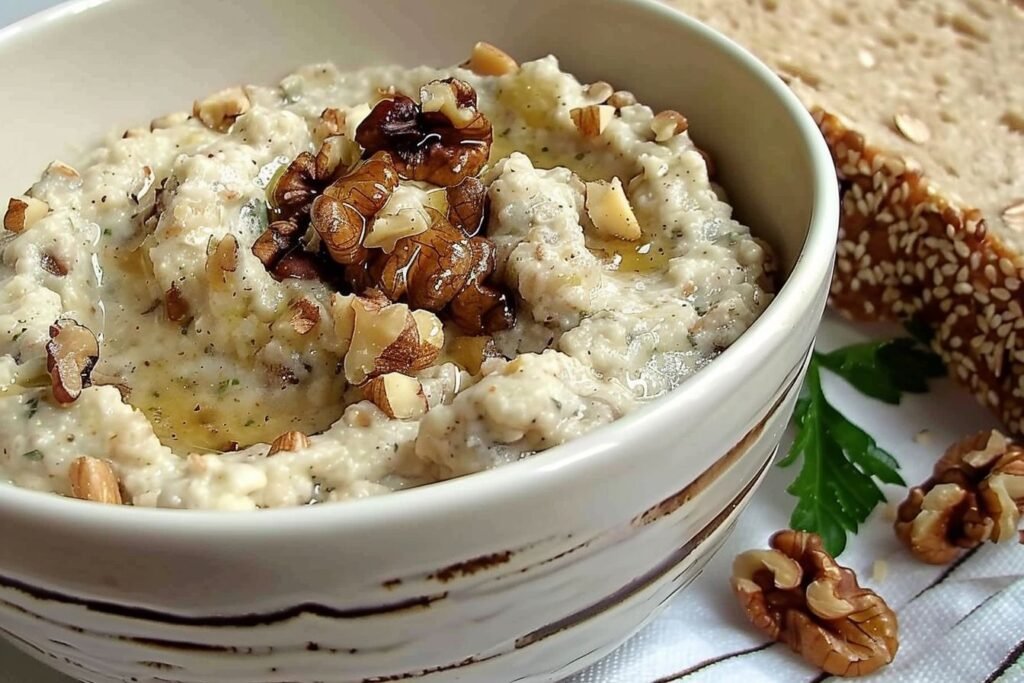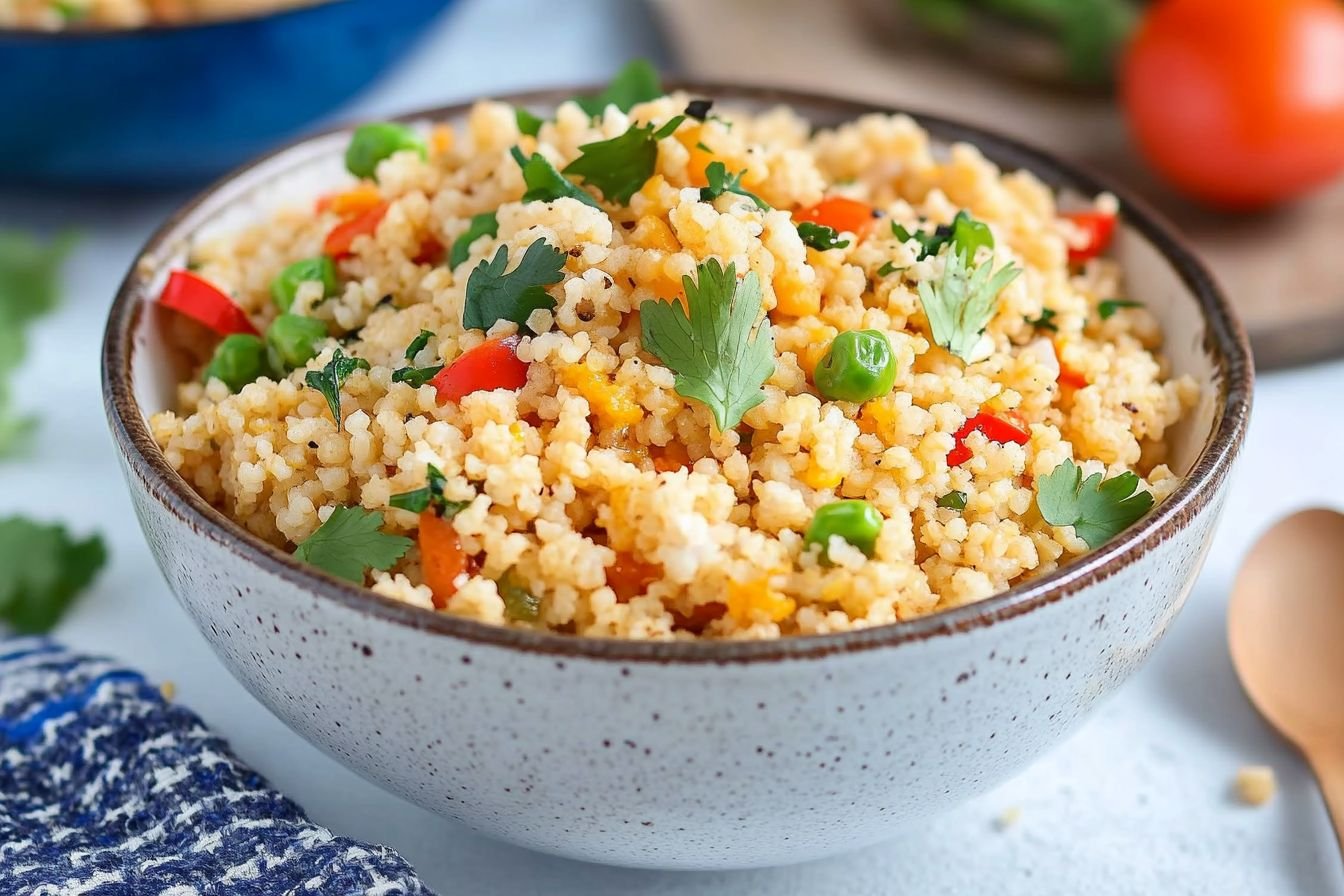Couscous with eggs is a delightful dish that combines simple ingredients for a wholesome meal. The combination of cooked couscous, vegetable stock, olive oil, grated carrots, butternut squash, frozen peas, and beaten eggs creates a tasty and nutritious option. Adding a sprinkle of soy sauce and chili flakes elevates the flavors even further.
Cooking this dish is quick and enjoyable. I love how the vibrant colors of the vegetables and the fluffy couscous come together. Each bite offers a satisfying blend that can easily become a favorite in my kitchen.
Couscous Overview
Couscous is a dish that originated in North Africa made from tiny granules of semolina wheat. It’s versatile and can be served as a side or a base for various toppings.
To prepare couscous, I typically steam the granules until they become fluffy. It’s a quick process that usually takes only about five minutes.
Couscous comes in several varieties, including:
- Traditional Couscous: The most common type, often found in Middle Eastern dishes.
- Israeli Couscous: Also known as pearl couscous, it’s larger and resembles small pasta.
- Whole Wheat Couscous: A healthier option made from whole grain flour.
I’m a fan of couscous for its neutral flavor, which allows it to absorb the tastes of accompanying ingredients. It pairs well with vegetables, meats, and sauces.
The dish is high in carbohydrates and provides some protein. It can easily fit into many diets, making it a popular choice worldwide.
I like adding spices, herbs, or even a drizzle of olive oil to enhance its flavor. Couscous truly offers endless possibilities in the kitchen!

Ingredients:
- 1 cup of cooked couscous
- 1 1/4 cups of vegetable stock
- 2-3 tablespoons of olive oil
- 2 small grated carrots
- A chunk of grated butternut squash
- 0.5 cup of frozen peas
- 2 beaten eggs
- Soy sauce and chili flakes to taste
How to make couscous with egg?
- Combine hot stock with couscous and stir thoroughly. Allow the couscous to absorb the liquid completely.
- Heat oil in a frying pan and sauté grated vegetables for approximately one minute. The aromatic fragrance is delightful!
- Add the couscous to the pan and continue cooking for another minute. Create a well in the center and carefully crack an egg into it.
- Gently stir the mixture until the egg is fully set and lightly coats the couscous.
- Serve the dish immediately and season to taste.
Nutritional Information
| Nutrient | Amount |
|---|---|
| Calories | 303 |
| Protein | 10g |
| Carbohydrates | 27g |
| Cholesterol | 163mg |
| Fat | 16g |
| Fiber | 3g |
| Iron | 1.6mg |
| Calcium | 57mg |
Serving Suggestions
Dish Presentation
For an appealing presentation, I often use a wide, shallow bowl. This allows me to display the fluffy couscous beautifully. I like to form a small mound in the center and place the egg on top, showcasing its vibrant color.
A sprinkle of fresh herbs, like parsley or cilantro, adds a touch of greenery and freshness. Drizzling a bit of good-quality olive oil can elevate the dish’s aesthetic and flavor.
I also like serving it with lemon wedges on the side. This offers a burst of brightness when squeezed over the dish. Adding a sprinkle of paprika or chili flakes provides a contrasting color and hints of spice.
Accompaniments and Pairings
To complement this dish, I often choose roasted or sautéed vegetables. Carrots, zucchini, and bell peppers add flavor and color. A simple side salad with mixed greens and a light vinaigrette works well too.
For a heartier meal, I pair this dish with grilled chicken or shrimp seasoned with Middle Eastern spices like cumin and coriander.
I sometimes serve with yogurt or a tangy tahini sauce for a creamy contrast. This blend of flavors and textures creates a delightful dining experience that I love to share with friends and family.
Storage and Reheating Tips
Refrigeration
- Cool Down: Let the dish cool to room temperature before refrigerating.
- Storage Time: Eat within 3-4 days for the best quality.
Freezing
If I want to keep it longer, I freeze the couscous.
- Freezing Steps:
- Portion the couscous into smaller, freezer-safe containers.
- Label each container with the date and contents.
- Storage Time: Use within 2-3 months for optimal taste.
Reheating
When I’m ready to have my couscous again, I follow these steps:
- Microwave:
- Place the couscous in a microwave-safe bowl.
- Add a little water to keep it moist.
- Cover and microwave for 1-2 minutes, stirring halfway through.
- Stovetop:
- Heat a non-stick pan over medium heat.
- Add a splash of water or broth.
- Stir until heated through, about 5 minutes.
Common Mistakes to Avoid
- Incorrect Water to Couscous Ratio: I often find that people use too much or too little water. A good rule is to use 1 cup of water for every 1 cup of couscous.
- Not Letting the Couscous Steep: After boiling water, let the couscous sit for about 5 minutes. This step is essential for getting the right texture.
- Overcooking the Eggs: I recommend cooking the eggs just until they are set. Overcooked eggs can turn rubbery and affect the overall flavor.
- Skipping Seasoning: It’s easy to forget seasoning. A little salt, pepper, and perhaps some herbs can elevate the dish significantly.
- Not Fluffing the Couscous: After it steeps, I always fluff the couscous with a fork. This helps prevent clumping and keeps it light.
Conclusion
Couscous with egg offers a delightful combination of textures and flavors. The fluffy couscous pairs beautifully with the richness of the egg, creating a satisfying dish.
I enjoy preparing this meal because it is quick and easy. It provides a nutritious option for breakfast, lunch, or dinner.
Whether served as a main dish or side, couscous with egg is a winner in my kitchen. It’s a simple recipe that never fails to impress.
Just so you know, baba ganoush with walnuts is a great light accompaniment for this dish.
Get that recipe now (by clicking the image below):





